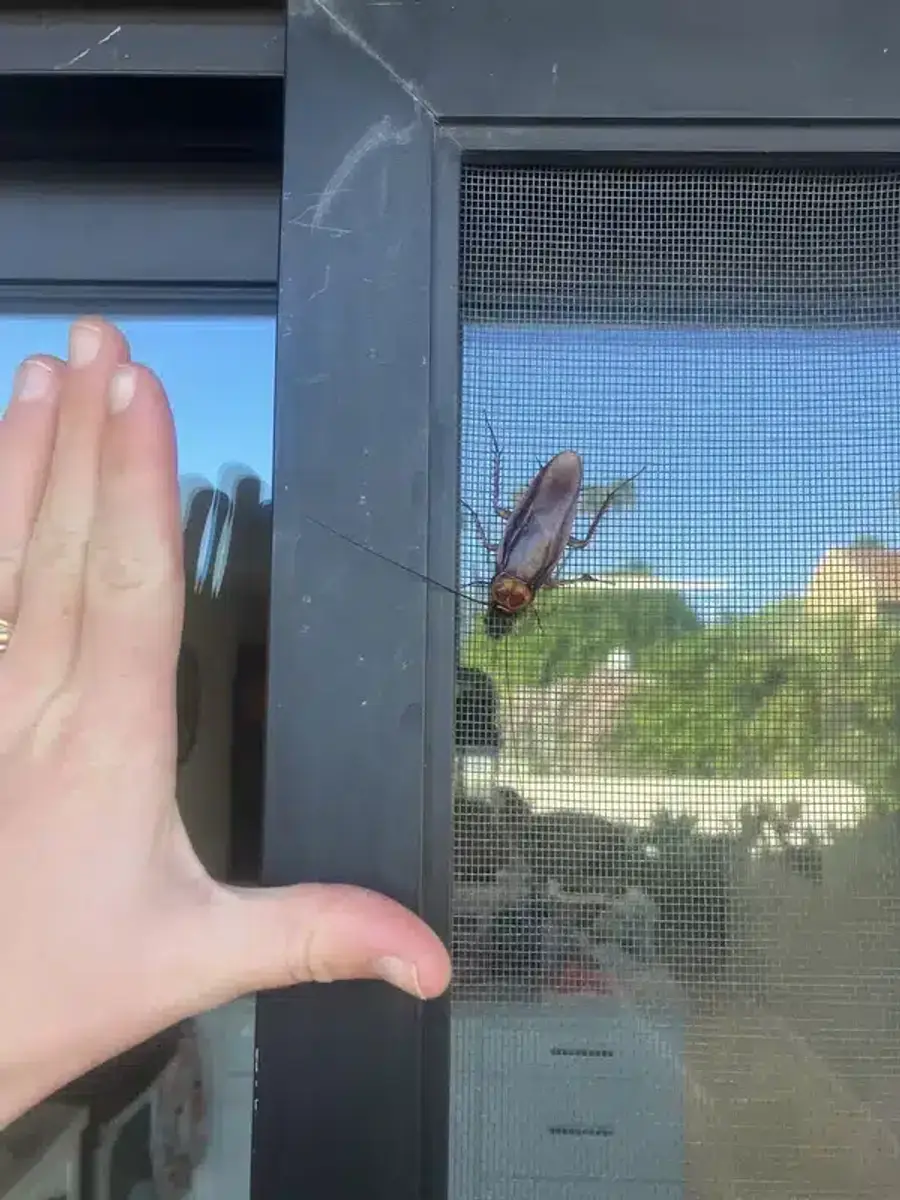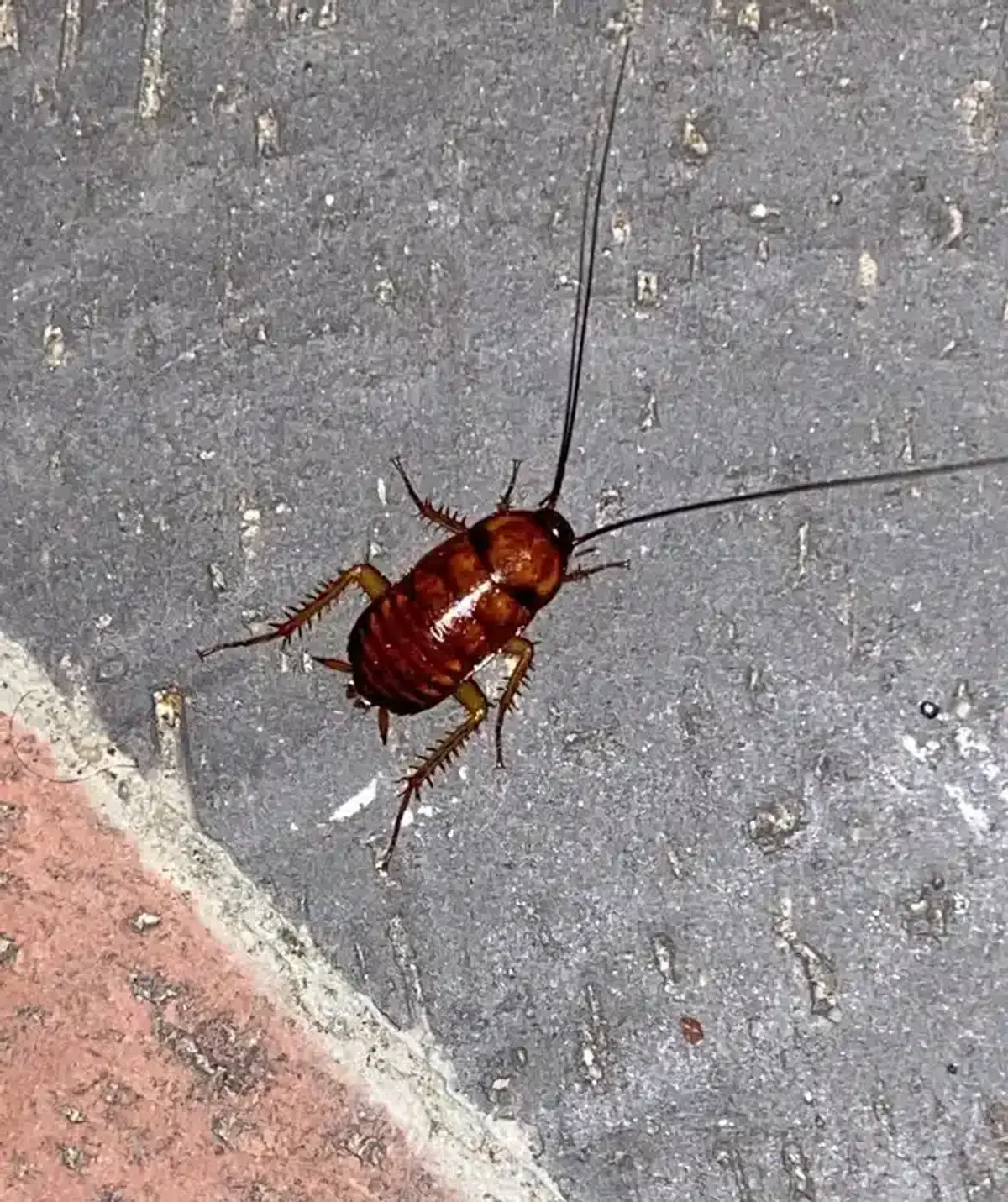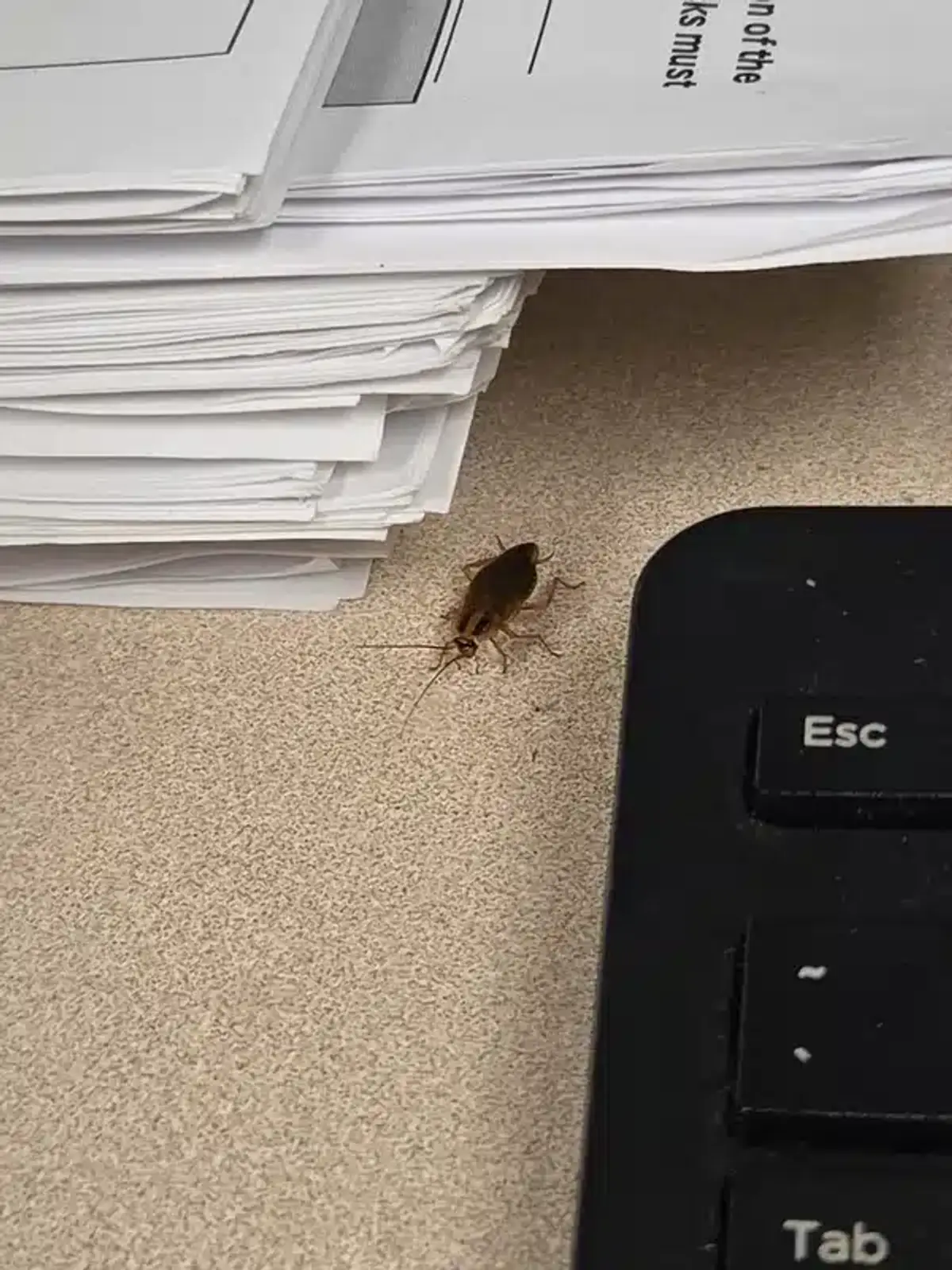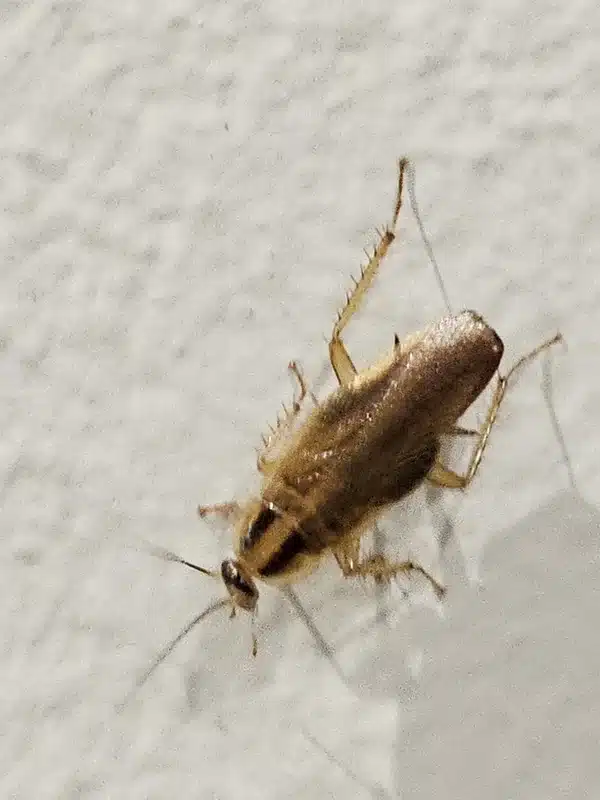Finding roaches in your home can be unsettling, but not all cockroaches are the same. The german roach vs american roach comparison reveals significant differences that affect how you should handle an infestation. Understanding these differences is crucial for effective treatment.
Over the years working in pest control throughout the DC metro area, I’ve seen countless cases where homeowners misidentified their roach problem. This mistake often leads to ineffective treatment and continued frustration. Let me walk you through the key differences between these two common species.

Size Differences Between German and American Roaches
The most obvious difference in the german roach vs american roach comparison is size. German roaches are significantly smaller, measuring about half an inch long when fully grown. You could easily fit one on your thumbnail.
American roaches, on the other hand, are much larger at 1.5 to 2 inches long. They’re about the size of your thumb and are actually the largest common household roach species. This size difference makes identification relatively straightforward once you know what to look for.


| German Cockroach | American Cockroach | |
|---|---|---|
| Size | ½ inch long | 1.5-2 inches long |
| Color | Light brown with dark stripes | Reddish-brown |
| Preferred Location | Kitchens & bathrooms | Basements & sewers |
| Reproduction Speed | 50-60 days | 6-26 months |
Roach Color and Marking Identification
Beyond size, color patterns provide reliable identification markers for the german roach vs american roach debate. German roaches are light brown with two distinct dark stripes running down their back behind their head. These stripes are like their fingerprint - once you see them, you’ll never mistake a German roach again.
American roaches display a different pattern entirely. They’re reddish-brown with a pale yellow band around their head area. This coloring gives them a distinctly different appearance that’s easier to spot because of their larger size.

Nymph Identification
Young roaches (called nymphs) also show distinct patterns. German roach nymphs are darker than adults with a single stripe down their back. American roach nymphs start gray-brown and gradually develop the reddish coloring as they mature.
Cockroach Infestation Habitat Preferences: Where You’ll Find Each Species
Location often provides the biggest clue in the german roach vs american roach identification process. These species have very different habitat preferences that reflect their survival needs.
German Roach Locations
German roaches prefer warm, humid areas close to food and water sources. In my experience, you’ll typically find them in:
- Kitchen cabinets and behind appliances
- Bathroom areas near plumbing
- Behind refrigerators and dishwashers
- Inside coffee makers and microwaves
- Cracks around sinks and countertops
Case Study: When Big Roaches Were Actually Small Ones
I remember one service call where a customer insisted they had “big roaches” in their kitchen. After careful inspection, we discovered the truth was quite different.
- Customer complaint: Large roaches seen occasionally in kitchen
- What we found: German roaches hiding in appliance cracks
- The issue: Small size made them hard to spot during quick glances
- Treatment approach: Targeted crack-and-crevice applications
This experience reinforced why proper identification is crucial - the wrong treatment approach could have allowed the infestation to continue growing.
American Roach Locations
American roaches prefer different environments entirely. They’re commonly found in:
- Basements and crawl spaces
- Sewer systems and floor drains
- Boiler rooms and utility areas
- Mulch beds near foundations
- Areas with high moisture levels
These larger roaches often enter homes from outside sources during hot, wet summer months when they’re seeking cooler conditions.

Reproduction Rates and Population Growth
Perhaps the most critical difference in the german roach vs american roach comparison involves reproduction speed. This factor dramatically affects how quickly an infestation can spiral out of control.
German Roach Reproduction
German roaches reproduce at an alarming rate. A single female can produce 18-50 eggs per case and complete her life cycle in just 50-60 days under ideal conditions. This means one female could potentially produce over 10,000 descendants in a single year.
The female carries her egg case until just before hatching, which protects the eggs and increases survival rates. This behavior makes German roach infestations particularly challenging to control.
What does the science say?
According to University of Michigan’s Animal Diversity Web, German cockroaches have one of the shortest development times among pest species. Research shows their reproductive success is directly linked to temperature and humidity levels, with optimal conditions allowing for continuous breeding cycles year-round in heated buildings.
American Roach Reproduction
American roaches reproduce much more slowly. They produce 14-16 eggs per case and take 6-26 months to complete development, depending on temperature. While still concerning, this slower reproduction gives you more time to address the problem.
Additionally, American roaches drop their egg cases rather than carrying them, making the eggs more vulnerable to treatment and environmental factors.
Essential Prevention Steps
- Early Detection: Check for egg cases, shed skins, or droppings in preferred hiding areas
- Moisture Control: Fix leaks immediately and maintain proper ventilation in humid areas
- Food Source Elimination: Store food in sealed containers and clean up crumbs promptly
- Entry Point Sealing: Seal cracks around pipes, cabinets, and appliances where roaches hide
Behavior Patterns and Activity
Understanding behavior differences helps explain why the german roach vs american roach treatment approaches vary significantly.
Flight Capabilities
American roaches are capable of short, clumsy flights, especially in warm, humid conditions above 85°F. German roaches, while they have wings, can only glide short distances and rarely attempt powered flight.
This difference affects how they enter homes and move between areas. American roaches might fly from trees to rooflines, while German roaches typically hitchhike in boxes, bags, or used appliances.
Daily Activity
Both species are nocturnal, but their activity patterns differ slightly. German roaches typically emerge soon after lights go out, while American roaches are often active later in the night. Seeing either species during daylight hours usually indicates a significant infestation.
Pest Control Treatment Challenges: Why Identification Matters
The german roach vs american roach differences directly impact treatment success. Using the wrong approach can waste time and money while allowing populations to grow.
German Roach Treatment Challenges
German roaches present unique treatment difficulties. They’ve developed resistance to over 40 different insecticides, including common household sprays. Some populations have even developed bait aversion, where glucose-based baits taste bitter to them.
What does the science say?
Research documented in scientific literature shows German cockroaches have developed resistance to over 40 different insecticide classes. Studies have identified genetic mutations that allow some populations to survive exposure to common treatments, making professional-grade rotation strategies essential for effective control.
Their rapid reproduction means treatment windows are narrow. Miss part of the population, and you’ll see numbers bounce back quickly. Successful German roach control requires:
- Non-repellent insecticides that spread through the population
- Growth regulators to disrupt reproduction
- Multiple treatment rounds spaced appropriately
- Thorough crack and crevice applications
American Roach Treatment Approach
American roaches are generally less resistant to treatments, but their larger size requires different strategies. Treatment typically focuses on:
- Exterior perimeter treatments
- Sewer and drain treatments
- Moisture control recommendations
- Exclusion techniques around entry points
The slower reproduction rate means you have more time between treatments, but the larger territory they cover requires more comprehensive approaches.

Cockroach Infestation Health Concerns and Disease Transmission
Both species in the german roach vs american roach comparison pose health risks, but the level of concern varies. German roaches carry over 30 bacterial species and multiple pathogens on their body surfaces.
The health risks include:
- Salmonella and other food poisoning bacteria
- Asthma triggers from shed skins and droppings
- Allergen production affecting children
- Contamination of food preparation areas
Because German roaches live closer to food preparation areas, they often present higher contamination risks than American roaches, which typically stay in basements and utility areas.
Common Roach Hiding Spots to Check
Knowing where to look helps with early detection in the german roach vs american roach identification process.
German Roach Hiding Spots
German roaches prefer tight spaces where they can touch surfaces on multiple sides. Check these often-overlooked areas:
- Behind refrigerator door gaskets
- Inside microwave control panels
- Crown molding in upper cabinets
- Screw holes in cabinet hinges
- Corrugated cardboard packaging
American Roach Hiding Spots
American roaches use larger hiding spaces, including:
- Sump pump areas
- Water meter vaults
- Crawl space block voids
- Floor drain connections
- Expansion joints in concrete
Pest Control Prevention Strategies
Different species require different prevention approaches. Understanding the german roach vs american roach preferences helps target your efforts effectively.
For German roaches, focus on:
- Eliminating food crumbs and grease
- Fixing water leaks promptly
- Inspecting incoming packages and appliances
- Sealing cracks around plumbing
For American roaches, emphasize:
- Moisture control in basements
- Sealing exterior entry points
- Maintaining proper drainage
- Regular cleaning of floor drains
Want to learn more about identifying different cockroach species? Check out our guide on big roach identification in Virginia for additional insights.
When to Call Pest Control Professionals
While knowing the german roach vs american roach differences helps with identification, successful treatment often requires professional expertise. This is especially true for German roach infestations, which can be extremely challenging to eliminate completely.
Consider professional help when you:
- See roaches during daylight hours
- Find egg cases or shed skins
- Notice a musty odor in affected areas
- Have tried DIY methods without success
Our licensed technicians have treated thousands of roach infestations throughout the DC metro area. We use products that have passed through our internal research team - materials we’d feel comfortable using in our own homes. Each treatment plan is tailored to the specific species and severity of your situation.
If you’re dealing with either German or American roaches, don’t wait for the problem to get worse. The faster reproduction rates of German roaches mean early intervention is crucial. For any questions about roach identification or to schedule an inspection, call us at 703-683-2000 or email us at info@bettertermite.com. We’re here to help you reclaim your home from these unwanted invaders.
Frequently Asked Questions
How can I tell if I have German roaches or American roaches?
+
Size is the easiest identifier. German roaches are about half an inch long with two dark stripes, while American roaches are 1.5-2 inches long with reddish-brown coloring. Location also helps - German roaches prefer kitchens and bathrooms, while American roaches are typically found in basements and damp areas.
Which type of roach is harder to get rid of?
+
German roaches are significantly more challenging to eliminate. They reproduce much faster (50-60 days vs 6-26 months), have developed resistance to many insecticides, and some populations avoid common baits. Their rapid reproduction means missing even a small population can lead to quick re-infestation.
Do American roaches and German roaches fly?
+
American roaches can fly short distances, especially in warm, humid conditions above 85°F, though they're not strong fliers. German roaches have wings but can only glide short distances and rarely attempt powered flight. This difference affects how they enter homes and move between areas.
Where do German roaches hide during the day?
+
German roaches prefer tight spaces near food and water sources. Common hiding spots include behind refrigerators, inside cabinet hinges, around sink areas, in appliance motors, and in cracks around plumbing. They seek areas where they can touch multiple surfaces simultaneously.
Why do I see American roaches in my bathroom at night?
+
American roaches are attracted to moisture and often enter bathrooms from basement areas or through floor drains. Heavy rain can force them from sewer systems into homes. They're nocturnal and seek water sources, making bathrooms attractive, especially during hot, dry weather.
How fast do German roaches multiply?
+
German roaches multiply extremely quickly. A single female can produce 18-50 eggs per case and complete development in just 50-60 days under ideal conditions. One female could potentially lead to over 10,000 descendants in a year, which is why early intervention is crucial.
Can I use the same treatment for both German and American roaches?
+
No, effective treatment requires different approaches. German roaches need crack-and-crevice treatments with non-repellent insecticides and growth regulators, focusing on kitchen and bathroom areas. American roaches require perimeter treatments, moisture control, and often exterior applications targeting basement and utility areas.
Are baby German roaches different from baby American roaches?
+
Yes, the nymphs (baby roaches) show distinct differences. German roach nymphs are darker than adults with a single stripe down their back. American roach nymphs start gray-brown and gradually develop reddish coloring as they mature. Size differences are apparent even in young stages.
With five years of hands-on experience in the pest control industry, George Schulz is a registered technician with the Virginia Pest Management Association and a proud third-generation professional in a family business that’s been protecting homes for over 57 years. He manages and trains a team of service pros while also leading internal research efforts—recently spearheading a deep-dive review of thousands of documents on pest control materials to hand-pick the most kid and pet friendly, most effective solutions tailored specifically for homes in the DC metro area.
